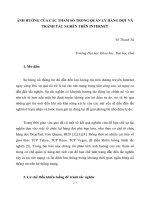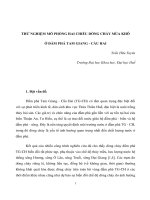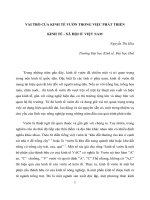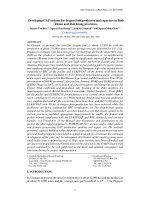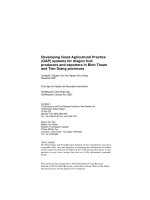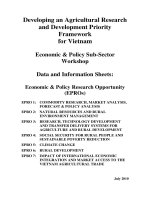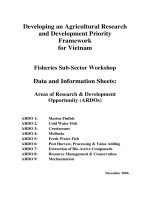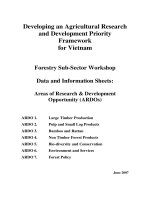Báo cáo nghiên cứu khoa học " Developing GAP systems for dragon fruit producers and exporters in Binh Thuan and Tien Giang provinces - MS6 " pdf
Bạn đang xem bản rút gọn của tài liệu. Xem và tải ngay bản đầy đủ của tài liệu tại đây (122.24 KB, 17 trang )
Ministry of Agriculture & Rural Development
CARD Project Progress Report
037/04VIE
Developing GAP systems for dragon fruit producers
and exporters in Binh Thuan and
Tien Giang provinces
MS6: Fourth Six-Monthly Progress Report
April 2007
1. Institute Information
Project Name
Developing GAP systems for dragon
fruit producers and exporters in Binh
Thuan and Tien Giang provinces
Vietnamese Institution
Southern Fruit Research Institute
Vietnamese Project Team Leader
Nguyen Van Hoa
Australian Organisation
The Horticulture and Food Research
Institute of New Zealand
Australian Personnel
John Campbell, Leonie Osborne
Date commenced
30 June 2005
Completion date (original)
March 2007
Completion date (revised)
September 2007
Reporting period
Fourth six monthly progress report
Contact Officer(s)
In Australia: Team Leader
Name:
John Campbell
Telephone:
+64 3 528 9106
Position:
Project Leader
Fax:
+64 3 528 7813
Organisation
HortResearch
Email:
In Australia: Administrative contact
Name:
Mrs Leonie Osborne
Telephone:
+64 9 815 8819
Position:
PA, Bioprotection Group
Leader
Fax:
+64 9 815 4202
Organisation
HortResearch
Email:
In Vietnam
Name:
Dr Nguyen Minh Chau
Telephone:
+84 73 893 129
Position:
Project Champion
Fax:
+84 73 893 122
Organisation
SOFRI
Email:
/vn
2. Project Abstract
Producers of dragon fruit in Vietnam have seen prices for their fruit decline by about 60%
since 2000, which can be attributed, in part, to their dependence on local and nearby
export markets. There are about ten major dragon fruit exporters in Vietnam but a
significant proportion of the total production is sourced from many small farmers. Returns
from dragon fruit could be significantly improved if small growers and exporters can gain
access to new high value markets in Europe and North America. Unfortunately, regulatory
requirements and recent consumer concerns over food safety and security mean that
Vietnamese growers can now only export to these high value markets if they have Good
Agricultural Practice (GAP) programmes in place. EUREPGAP is a comprehensive and
auditable GAP programme which is now the minimum fruit quality, safety and
sustainability standard required by most supermarket chains in Europe. This project will
develop the basis for EUREPGAP implementation amongst groups of dragon fruit
growers and BRC standards in a pilot packhouse in the Binh Thuan province, to enable
Vietnamese growers to export dragon fruit to high value European markets. When
implemented, the pilot will provide a model GAP system for adoption by other dragon
fruit farmers and packers in the Binh Thuan and Tien Gieng Provinces and also to other
Vietnamese fruit sectors.
3. Executive Summary
This report is the fourth progress report for the Collaboration for Agriculture and Rural
Development (CARD) project 037/04VIE and covers the period 1 September 2006 to 28
February 2007. For continuity of reporting much of the 3
rd
six-monthly report content has
been retained; this has now been updated and the achievements for the fourth six-monthly
period are included in this report.
The HortResearch project leader has made one visit to Vietnam during this reporting period as
scheduled: 18 November to 12 December 2006.
There have been no changes to project personnel during the reporting period. Mentoring of
the Vietnam project team has been ongoing. Southern Fruit Research Institute (SOFRI),
Ministry of Agriculture and Rural Development (MARD), Department of Agriculture and
Rural Development (DARD) and commercial personnel are included in the training which
covers all facets of Good Agricultural Practice (GAP) at the various levels. Enhancement of
the national capability of people and infrastructure continues to be given high priority by the
project for ultimate sustainability obligations.
“Introduction to Internal Auditor Training” Courses were delivered to selected SOFRI staff
and to the pilot packhouse key personnel.
Mr Nguyen Huu Hoang reported on his study tour to New Zealand and also used his
Microsoft® PowerPoint presentation as a training tool when establishing GAP in the pilot.
Field observations for the farmers’ benchmarking survey were completed in the first reporting
period. The data were subsequently translated into English, entered into a web based database
and analysed. The benchmarking survey report was prepared by HortResearch personnel and
delivered as a PowerPoint presentation by the project leader to SOFRI personnel also packers,
farmers, MARD and DARD personnel of Binh Thuan during March/April.
Selection of a packer/exporter and farmer group for the Project Pilot to receive project input,
confirmed during the September 2006 visit, was formalised. Training of the Pilot members for
improvement towards British Retailers Consortium: Global Standard – Food (BRC) for the
packer and EUREPGAP for the farmers continues. The training involves quality systems,
health and safety, technical, product traceability and environmental issues that will, when
adopted, enable the participants to meet compliance with the required standards.
A component of the field visits by the project leader has been to observe the current practices
of the dragon fruit farmers and packers. These findings have formed the basis for the quality
manual preparation. The dragon fruit quality manuals for the farmer and packer have been
developed in a way that closely relates to the current practices, includes appropriate
improvements to enable the farmer and packer to comply with the EUREPGAP and BRC
standards, and are user friendly. Most of the manual has been translated into Vietnamese. The
manual has been issued to the pilot packer and farmers. The standards being implemented
incorporate all issues identified in the project objectives.
During the project leader’s December visit, extensive training was provided to the pilot
packhouse senior staff and farmers which involved all the physical changes to facilities,
quality systems establishment, personnel training, compliance issues and auditing
requirements as documented in the Dragon fruit Quality Manual for the Pilot to reach
compliance with BRC and EUREPGAP Standards.
High value markets are being identified and evaluated for dragon fruit to be exported from
Vietnam, both for fruit when certified and for the project-improved fruit exported during the
transition period towards certification. A financial incentive is to be paid by the packer for
qualifying fruit during the transition period.
Inputs identified in the project document for Year 1 had been purchased.
The CARD dragon fruit project continues to be well publicised in the local and national
newspapers and television during this reporting period.
4. Introduction & Background
Objective 1:
To increase small holders’ competitiveness and capacity to supply dragon fruit to high-value
international markets, introducing new concepts of food safety, environmental responsibility,
sustainability and worker safety into their production practices
Objective 2:
To provide technical support and training for Vietnamese extension/researchers to improve
their capacity in group training procedures for GAP implementation in dragon fruit
The outputs expected include adoption of new practices that are required for entry into the
European market, and empowerment of small farmers to negotiate improved supply
arrangements. Vietnamese personnel from SOFRI, Department of Agriculture and Rural
Development (DARD) and the private sector will be trained in the field in Vietnam and two
SOFRI members will undertake a study tour to observe GAP systems in the fruit industry in
New Zealand.
It is intended that the development of the Vietnamese personnel, both in the public and
private sectors, will be through the practical application of:
¾ Establishing the current status of the dragon fruit industry against EUREPGAP standards
through a benchmarking survey
¾ Improving the current understanding of dragon fruit agronomy within SOFRI and
establishment of systems for constant improvement and problem solving
¾ The development of pilot models of EUREPGAP-compliant Exporter/Packer/Farmer
groups in the field
¾ Establishing manuals, Codes of Practice and the development of training material that are
appropriate, user friendly, developed by the Vietnamese extensionists, and appropriate to
the dragon fruit industry for transfer to subsequent “models” and ultimately other crops
¾ Establishing the required quality systems for the dragon fruit industry to adopt and obtain
proof of the system robustness, by obtaining EUREPGAP certification for the pilot model
¾ Maximising the impact of current initiatives to develop GAP in the dragon fruit industry
through full participation in the Dragon fruit GAP Project.
5. Progress to Date
Implementation Highlights
5.1.1 Benchmarking
The field portion of the benchmarking survey was completed by the SOFRI team in late July
2005. Some 124 farmers from Binh Thuan and 30 farmers from the Tien Giang Province
were questioned. The SOFRI team recorded farmer information for the formal EUREPGAP
oriented questionnaire (Inception Report: August 2005 Appendix 2) and also recorded
additional current agronomic and technical information relating to the surveyed farmers
dragon fruit production practices.
The benchmarking survey data were analysed at HortResearch by Dr Jim Walker and Patrick
Connolly who also prepared a PowerPoint presentation (Appendices 1 and 2 of the 3
rd
Progress Report, August 2006) for delivery during the scheduled March 2006 visit. It was
originally planned for Dr Walker to travel to Vietnam to make the PowerPoint presentations,
but this was not possible because of his other work commitments.
As a consequence, the benchmarking PowerPoint presentations were delivered by the project
leader during his March/April visit, initially to the staff of SOFRI then to DARD and some
industry personnel in Binh Thuan. The presentation has subsequently been used as a training
tool for the farmers and packers of the area.
During the PowerPoint presentations, care was taken to emphasise the standards observed in
the survey and to relate those conditions to the standards required to meet the high value
customer-driven demands.
The PowerPoint presentation and other information contained in the benchmarking survey
database are being used by the SOFRI scientists during their research work.
5.1.2 GAP Manual Development
The Dragon fruit Quality Manual has been completed in English and is currently being
translated into Vietnamese. This manual was to be completed by the end of March 2006
(milestone #4) in the draft form but had been delayed because of time constraints and the
clarification of copyright issues. The manual has been developed specifically to meet the
needs of the quality systems of the project pilot. The manual has been developed at the
farmer level to the EUREPGAP Standard and in the packhouse to the BRC Standard and apart
from being a living document, has been completed in the final form. Future use of the manual
to other packhouses will have the advantage of a manual that is an actual working document
while being adapted to their particular packhouse/farm application.
Full verification of the appropriateness of the Dragon fruit Quality Manual to address the
specific standards of BRC and EUREPGAP and the requirements of the customer, the pilot
packer and farmers will be confirmed by the Independent Certifying Body. Compliance
assessment by the Certifying Body was planned take place during December 2006; however,
the pilot was not ready and significant modifications were planned/being implemented for the
packhouse to better comply with the standards. An assessment/internal audit is planned
during the next visit of the project leader and the decision on when to call for the Certifying
Body inspection will be made at that time.
5.1.3 Develop Implementation Plan – Completed: First Progress Report
5.1.4 Establish pilot GAP programme for year one
As documented in the February 2006 report, the packhouse of Mr Hiep of Queen Farm,
Hoang Hau Dragon Fruit Farm Co Ltd, was identified to be the project’s pilot for packing
dragon fruit. Subsequently project personnel negotiated with Mr Hiep to define the level of
commitment to and cooperation with the project for the development of his packhouse to
meet the BRC Standards and project expectations. During the July visit by the project leader,
a contract between Mr Hiep and Dr Chau as Project Champion was generated and signed.
Agreement to work together with the pilot is based on the memorandum of understanding that
was under discussion as described in the February 2006 report. Indeed many of the issues for
improvement highlighted by the project during the previous visits were being or had been
addressed by Mr Hiep.
Mr Hiep has committed his resources and staff to the project pilot development. As well as
committing the packhouse to the project, Mr Hiep also committed his 70 hectare, dragon fruit
producing farm to the pilot to be developed for compliance with the EUREPGAP Standard.
During this reporting period Mr Hiep indicated that he was proposing development of a large
packhouse modelled on the pilot packhouse for future expansion; indeed, construction for
buildings to house the packing facilities was underway at the time of the project leader’s visit
in December.
The Dragon fruit Quality Manual was presented to Mr Hiep in the English version and the
Vietnamese version, which was complete apart from the Position Description section.
During this reporting period the project team conducted intensive training/mentoring sessions
with the pilot’s staff holding responsible positions within the packhouse and participating
farm owners/managers. The areas of training and guidance covered included:
¾ The project scope and delivery
¾ The customer and customer demands
¾ Quality systems, their purpose, structure, establishment and management
¾ Defining the “process” on-farm through the packer to the exporter
¾ Linkages between farmer and packer and responsibilities and expectations
¾ The dragon fruit quality manual, its development, scope and application
¾ Feedback to ensure the “appropriateness/workability/fit’’ of the manual for the
intended purpose
¾ Identification, guidance and purpose for physical improvements required by the
project pilot facilities, both on-farm and at the packhouse, to comply with the dragon
fruit quality manual
¾ Identification of positions in the “process” and ensuring that responsibilities had been
correctly documented in the position descriptions within the manual
¾ Provision of training to people designated for positions of responsibility in the pilot
¾ The role of the internal audit
¾ The responsibilities of the Internal Auditor
¾ Processing of corrective action and sustainability.
5.1.5 Implementation of Quality Systems
In previous reporting periods the project had provided training in quality systems to any
identified group that would benefit from adopting GAP. Confirmation of the pilot
participants and pilot scope during the last reporting period saw the training programme of the
project become more focused and address the specific needs of the farmers and packer of the
pilot, to enable them to meet compliance with the standards before the proposed assessment
visit by the Certifying Body. During this reporting period, training provided was very specific
to the pilot’s needs and included all components as detailed in the Dragon fruit Quality
Manual, guidance on physical changes required at the packhouse and on the farm, Internal
Auditing and for an understanding of the quality systems and the need to be market driven.
Choice of quality system standards:
The project chose the existing BRC and EUREPGAP quality standards as the most suitable to
meet the demands of the target customer while protecting the interests of the Vietnamese
stakeholders. At the farmer level the EUREPGAP Standards are being applied and at the
packhouse the BRC Standards are implemented. Both standards complement each other to
ensure the dragon fruit produced and packed is confirmed as safe, legal and of the quality
expected by the high value market customer.
The choice of the two standards has been determined by the access conditions to high value
markets identified in the project document. The project is very “customer driven” and the
quality system will meet all the customer’s requirements when fully implemented and will
specifically provide documented proof of compliance for safe, legal quality control and
traceability for the entire product during the production and packing processes. The quality
systems developed will easily respond to any additional requirements from specific
customers.
The quality checking and documentation systems being employed in the pilot can also protect
the farmer and packer from claims for damage to product (non-compliance issues) subsequent
to the product leaving the packhouse.
The current process and status of the quality system of the pilot is:
¾ Pilot participants identified and their association with the project formalised
¾ The BRC Standard has been selected for the packhouse quality system
¾ The EUREPGAP Standard has been selected for the farmer quality system
¾ The Dragon fruit Quality Manual has been developed in English
¾ The Dragon fruit Quality Manual is being translated into Vietnamese
¾ The English and Vietnamese versions of the manual have been distributed to the
packer and relevant portions of the manual provided to the farmers of the pilot
¾ Physical changes, required by the quality system, in the packhouse and on the farm
have been initiated and in some areas completed
¾ Vietnamese project personnel have the skills to train dragon fruit industry stakeholders
in all areas of quality
¾ Intensive and targeted training has been provided to packhouse staff and farmers
¾ Quality systems are being developed in the pilot as described in the manual, under the
training and guidance of the SOFRI project team
¾ Health and Safety and Risk analysis studies have been made for the pilot and
documented as required by the standards
¾ Internal Audits have commenced to determine the quality status of the pilot with
corrective action and training process being implemented
¾ It is proposed to call for an external audit by a Certifying Body when the pilot is
operating in compliance with the standards as verified by the Internal Audits.
5.1.6 Review Compliance
The project leader negotiated with Société Générale de Surveillance (SGS Vietnam), (in
Vietnam, Regional Indonesia and New Zealand) an International Certifying agency, to
provide an estimate for certification evaluation of the project initiatives. Quotations for the
inspection and certification of project farmers and the packer were received from SGS
Vietnam and subsequently a proposal was presented to CARD for the funding of the SGS
services. CARD approved the funding of the External Audit and Certification services and
this component has been included in the project as a new and separate milestone.
During discussions with SGS at their Ho Chi Minh office, the project team were informed
that SGS Vietnam now have trained inspectors for both EUREPGAP and BRC Standards.
Internal reviews of the pilot have been undertaken in the form of BRC/EUREPGAP Internal
Audits. The data collected have been used to determine the compliance status of the project
pilot development and to initiate/tailor corrective action and training. It is intended that the
learning process of the pilot development will be adapted for subsequent training during the
outreach programme.
5.1.7 Expanded Year 1 Programme and delivery to additional farmer groups
Word of the CARD dragon fruit project and how it can assist packers and farmers access high
value markets is spreading in Vietnam and the SOFRI project team continues to receive
serious approaches from interested parties for assistance.
5.1.8 Implement Year 2 training
Farmers and packers showing an interest in the project are being included through invitation
to training sessions being undertaken, or are mentored separately as time permits. Following
success of the pilot it is expected that this training will become more formal and serious. At
this stage it is also expected that the training will be done utilising the increasing capability of
the Vietnamese personnel.
Smallholder Benefits
During the project scoping and subsequent project implementation visits by HortResearch
personnel considerable effort has, and will continue to be, made to identify individuals both in
the public and the private sectors who have the capacity to be leaders of change, and quality
systems development, improvement and maintenance.
A high priority is being given to all aspects of National Capacity Building to ensure
sustainability upon project completion.
The project has tried very hard and expended a lot of project time on the identification of
small holder farmers and their subsequent quality training to fulfil the project document’s
obligations, but it still remains that the small holder farmers will not commit themselves to be
sustainable to GAP at the level required by the customer and the project. For this reason the
project accelerated the development of the pilot to demonstrate that GAP is viable at the small
holder farmer level. Farmers are being welcomed into the project training programme when
they step up to the required commitment to customer standards.
As the pilot develops towards the quality Standards of BRC and EUREPGAP, high value
markets are being identified. It is intended that product from the pilot will be, following
negotiations with the customer, exported in a form that can go directly to the high value
market and not be subject to any rework in the country of destination. It is the desire of the
project to maximise returns and reduce waste from product exported to ensure increased
revenue for the farmer and sustainable returns for the service operators such as the packer and
exporter.
Capacity Building
Initiate capability building of Vietnamese project collaborators
Capability building of Vietnamese project collaborators has again advanced dramatically over
this reporting period. Dr Chau has set up an environment at SOFRI that is encouraging his
staff to adopt the GAP initiative. This environment is greatly assisting the project leader to
transfer his quality skills to the project team and subsequently to farmers and packers. The
Vietnamese project collaborators have an excellent understanding of GAP, and are showing
confidence in delivering the project training to farmers and the packer both while the New
Zealand project leader is in Vietnam and also between visits.
Mentoring and communication, both ways, between the project leader and the Vietnamese
team, are excellent. Dr Chau’s enthusiasm for the CARD project’s success continues to lead
to the establishment of GAP support facilities being developed at SOFRI that, while outside
the scope of the project, are required by a future GAP-driven horticultural industry and will
ultimately be of benefit to the project and its sustainability. It has been disappointing that
DARD personnel in the Binh Thuan Region have shown a reluctance to embrace the dragon
fruit to the level anticipated by the project.
A formal Internal Auditor Course was presented to eight appropriate SOFRI staff by the
project leader and Mr Nguyen Huu Hoang. The New Zealand Organisation for Quality
(NZOQ) gave official approval for the project leader to use a percentage of the same course
material as that used during Internal Auditor training in New Zealand. This is the same
material as the two day course that Mr Hoang attended during his New Zealand study tour in
June 2006. Because of the requirement of NZOQ to only use a portion of their course
material the SOFRI training was done over one day and was called an “Introduction to
Internal Auditing”. (Appendix 1: Course content, participant names and Certificate of
attendance). A less formal Internal Auditor training course was also presented to the senior
pilot staff/participants.
Such was the response to the SOFRI Internal Training course that the project leader has been
requested to present the full two day course on a future visit. The project leader is seeking
approval from NZOQ to use their material and present the course: initial indications are that
the project leader will meet the NZOQ presenter qualification and experience criteria.
The scope of NZOQ Internal Auditor training course material presented was a real eye opener
for attendees.
Publicity
During this reporting period the project leader prepared a draft paper on “Quality Systems for
Good Agricultural Practice of Dragon fruit Production, Packing and Export” (Appendix 2).
The paper was prepared as part of SOFRI’s commitment to publish a document about
“Quality in the Vietnam Horticulture Industry”. It was also intended that the paper would
provide some background to the decision making process employed by this project and to
assist other quality practitioners when implementing quality initiatives in the future.
Project Management
There has been no change to the Project Management team during the reporting period. The
project team continues to work well together with excellent, friendly, transparent and honest
communication.
Equipment purchases for the project for Year 1 and Year 2 are complete. A table of
equipment purchased, the identification information, equipment location and responsible
person appeared in Appendix 5 of the August 2006 report.
6. Report on Cross-Cutting Issues
Environment
Environmental issues identified during the benchmarking survey continue to be addressed as
part of the technical transfer presentations to farmers. They include:
¾ Safe use of agrichemicals
¾ Appropriate use of fertilisers to provide good plant nutrition without damaging the
environment
¾ Disposal of human waste and grey water
¾ And other areas identified in the standards of EUREPGAP and BRC.
Gender and Social Issues
The CARD dragon fruit project implementation will systematically address gender and social
issues. For example, Good Agricultural Practices demand good working conditions,
appropriate treatment of labour, observation of good health and safety practices, etc. and
equal opportunity for both men and women.
Documentation of good working conditions, responsibilities and accountabilities and
conditions now appear in the Dragon fruit Quality Manual text and specifically in the Position
Description section.
7. Implementation & Sustainability Issues
Issues and Constraints
At the farmer level:
¾ Issues and constraints at the farmer level remain unchanged from those reported in
previous reports.
¾ The role of the collector, through providing early cash flow for the farmer, sometimes
harvesting the crop and providing transport for the fruit, remains a major constraint to
fruit traceability. Traceability is a “major” requirement of GAP production.
¾ The VNCI-developed Grade Standards and a photographic wall chart for dragon fruit
as described in the February 2006 report have proved unsuitable for the purposes of
the CARD project Pilot.
At the packer level:
¾ The lack of Wall Chart Grade Standards is also a constraint to packhouse quality
system development and operations.
¾ A potential issue/constraint at the packer level could be delays in implementing all the
quality system, physical change, and personnel training required to meet manual
instructions for compliance to the standards.
At the exporter level:
There has been no reported improvement to the two very serious issues and constraints that
become evident during the August 2006 reporting period:
¾ All fruit being airfreighted from the Ho Chi Minh City airport are scanned in the
individual carton state. While the integrity of the individual carton security remains
intact, a major problem occurs during the disassembly of the consignment. It has been
reported that: cartons of fruit out of coolstorage are being held on the tarmac awaiting
the scanning process; cartons are sometimes covered by tarpaulin for a period of time
where fruit heats and cartons can become water soaked; cartons from different
consignments become mixed. The loading process is determined by the availability of
plane containers.
¾ Airlines used to airfreight dragon fruit from Vietnam do not respect the perishable
nature of dragon fruit and consignments have been reported as arriving in either a
heated or a frozen condition – with no value in the market and ensuing legal battles to
get compensation.
At the market level:
¾ The high value markets, especially in Europe, require fruit that meets EUREPGAP
and BRC compliance for production and packing and handling.
¾ As project implementation advances, there will be fruit available for export that will
be close to meeting the standards but not certified. It is important that this transition
fruit is exported to a high value market that produces improved returns to the farmer.
¾ At this stage, market availability for the transition fruit and greater returns are not
guaranteed.
At the project level:
¾ While not a major constraint, improvement to the SOFRI communication systems
would be an advantage.
¾ As the CARD project is the first to implement GAP in the Vietnamese horticulture
industry, it is finding a dearth of infrastructure to support this initiative. National
infrastructure deficiencies for GAP production are being developed on a “project
specific” basis. However, it is not certain that these preparations will eventually meet
the standards required by the certifying agency.
Options
At the farmer level:
¾ The packer has increased the price paid for quality-compliant transition fruit.
¾ No provision has been made for the collector in the project pilot. A protocol will be
subsequently prepared for the collector to operate in a way that meets the quality
systems standards. The protocol will include auditing of collectors to ensure they meet
compliance and the biggest issue of traceability is being addressed.
¾ Wall charts tailored to the specific needs of the project pilot (dragon fruit industry) are
being developed by SOFRI personnel. The charts are based on a dragon fruit quality
paper written from earlier research done by SOFRI and HortResearch scientists, still
to be published.
¾ High value markets are being identified in Europe and the United Kingdom.
At the packer level:
¾ The wall charts being generated and will be utilised through every stage of the supply
chain to the customer.
¾ Project manuals and training are being provided for project recipients.
¾ Intensive training for the pilot packhouse senior staff and farm managers/owners has
continued during this reporting period and has included: BRC Standards; Quality
Manual content, purpose and use; packhouse changes to meet requirements; personnel
training/understanding; packhouse operations; quality systems; Internal Auditing
processes; Certifying Body.
At the exporter level:
The two very serious issues and constraints identified have the potential to nullify all the
efforts of the dragon fruit project. Resolution of these constraints is outside the scope of the
dragon fruit project but they have been brought to the notice of Dr Chau and will be presented
to the other project which has the responsibility to deal with supply/value chain issues in
Vietnamese horticulture. Leaders in the horticulture industry are aware of the constraints.
¾ The externally audited quality systems being implemented by the project are of such a
standard that there should be no need for cartons of dragon fruit to be disassembled
from the consignment or scanned. An exemption from scanning for these
consignments would be appropriate.
¾ Airlines airfreighting dragon fruit from Vietnam must respect the perishable nature of
the fruit and freight at the correct temperature. Airlines failing to comply should not
be used (will not be used by the project when exporting compliant fruit).
At the market level:
¾ The project has negotiated a premium to be paid by the packer for farmers’ fruit that
meets the GAP standards during the transition period.
¾ New initiatives to access high value markets are progressing and it is expected that
long-term beneficial supplier/customer relationships will materialise.
At the project level:
¾ SOFRI is currently improving its communication systems.
¾ The CARD project continues to encourage the establishment of appropriate
infrastructure to support the quality systems being developed in the dragon fruit
industry.
Sustainability
Sustainability is being addressed by the project through:
¾ Development of the national capacity. This reporting period has seen a great increase
in national capability and understanding of horticultural quality systems. The
improvement has been particularly noted in the SOFRI project team in their
understanding of “quality”, their willingness to train others and enthusiasm for the
project delivery. Every effort is being made to transfer the knowledge gained by Mr
Hoang during his study tour to New Zealand to all project recipients. An Introduction
Internal Auditors’ course was presented during the project leader’s
November/December visit to SOFRI staff and senior pilot personnel
¾ The project leader was involved in a CARD (GTZ) study tour of senior Vietnam
personnel to HortResearch at the Mt Albert Research Centre on 28 February. The
study tour purpose was “to expose leading agricultural research sector decision
makers to the approaches taken by Australia and New Zealand to the reform of the
agriculture research sector in both countries”. The study tour was seen as an integral
part of developing an active and appropriate infrastructure in Vietnam to support the
quality initiative piloted in the dragon fruit project. The briefing document and a list
of participants for the Study Tour is contained in Appendix 3 and the project leader’s
PowerPoint presentation is included in Appendix 4
¾ Training of exporters, packers and farmers by practical demonstration while
establishing the pilot
¾ Establishment of appropriate infrastructure within Vietnam to support the project and
the current GAP quality initiative in the horticulture industry
¾ Systematic expansion of the model to other groups and areas
¾ Provision of the critical mass of EUREPGAP/BRC Standards-compliant fruit and
processes for high value market evaluation as early in the project as possible, to
demonstrate the financial viability of having robust quality systems in place
¾ Communication of the merits of health and safety, environmental and social reasons
for GAP implementation – especially for farmers
¾ The implementation of constant improvement and installing of systems to prevent
slippage back to old ways.
Good progress has been made in these areas during this reporting period. It is expected that
the pilot will be operating sustainably at compliance with the standards in preparation for the
external certification inspection/audit during the next reporting period.
8. Next Critical Steps
The next critical steps are continuation of the project directive, which involves:
¾ Mentoring of Vietnamese project personnel
¾ Completion of the translation of quality manuals based on EUREPGAP/BRC
Standards, for the farmers and packer. The manuals include Codes of Practices,
Protocols and Position Descriptions for specific functions, Grade Standards for fruit
maturity and quality, identification of Certified Service Providers, etc.
¾ Establishment of the documented quality systems on the pilot farms and packhouse to
reflect the documented quality system
¾ Training of farmers and packhouse operators to ensure their operations “match” the
intent of the quality manual
¾ Conducting internal auditing to confirm compliance is being met and appropriate
corrective actions are being implemented.
¾ Arrange for SGS Vietnam, as the appropriate Certification Body, to audit the
farmer/packer pilot when the pilot has been operating in compliance for a period that
demonstrates competence. Fine tuning of the pilot structure for certifying purposes
requires some negotiation with SGS to ensure the ongoing inspection and certification
costs to farmers and the packer are kept to a minimum.
¾ Identifying high value markets to which to export certified EUREPGAP/BRC fruit.
Testing those markets with transition fruit to determine “Client needs” and an early
indication of higher profits (if any) to encourage farmers to make the change to GAP.
Constraints within the project scope:
There has been no change in constraints for farmers to embrace GAP fully at a level to meet
the EUREPGAP Standards. The project-negotiated increase in dragon fruit price per kilo from
the packer for fruit from GAP transition farmers has helped to increase farmer interest.
¾ Farmers need demonstration that their energy to produce GAP fruit will indeed
materialise in higher returns.
¾ Farmers require access to development and seasonal finance at an economical rate.
¾ The role of the collector through purchasing the farmers’ fruit either at the farm gate
or on the dragon fruit plant provides early cash flow for the farmer but prevents the
application of fruit traceability systems.
Mitigation:
¾ Farmers (and the packer) are being encouraged to implement GAP for environmental,
family/staff health and safety reasons as well as accessing high value markets.
¾ Negotiations with high value markets are progressing to determine actual values for
the fruit that meets compliance. Those markets will be tested with transition fruit prior
to certification being achieved. It is anticipated that higher fruit returns will encourage
more farmers to adopt GAP production practices.
¾ The need to identify seasonal and development finance providers continues to be
highlighted.
¾ It is recommended that farmer training in small business and financial management
should accompany any provision for seasonal and development finance.
¾ Financial independence for the farmer will greatly reduce the power of the collector
over the farmer’s operations.
Constraints outside the project scope:
It has been brought to the attention of the project team that all airfreight dragon fruit being
exported through Ho Chi Minh City airport must go through the airport scanner. Security of
the individual carton is not compromised because each carton has been taped top and bottom
and a heat sealed band applied but the pallet of cartons from the packer has to be broken
down. This can result in:
¾ A breakdown in the integrity of the documentation of the consignment
¾ Potential for cartons from different pallets to be mixed
¾ Cartons of dragon fruit being damaged during handling
¾ Cartons of fruit exposed to the elements – left in the sun; or water damaged during
rain.
It has also been noted that airlines freighting dragon fruit from Vietnam do not respect the
product and there have been reports of cooked and frozen fruit arriving in the market place.
Mitigation:
These two issues were brought to the notice of the project team at the end of the July/August
visit to Vietnam. Both issues have the potential to destroy all the project efforts to develop
safe, legal and high quality dragon fruit from the farm through the packer and exporter to the
customer. The project leader is attempting to overcome these potential problems by:
¾ Legislation/standards search for airport handling of perishable fruit and vegetables
¾ Legislation/standards search for airline carriage of perishable fruit and vegetables
¾ Creating awareness of the potential problem with the Vietnamese Institution for them
to lobby Government for a resolution of the problem
¾ Bring the problem to the notice of other projects in the area – particularly in the area
of identifying and resolving constraints to the value chain.
The quality system being applied to the dragon fruit industry will have the capability to
determine where problems occur in the delivery chain, but airlines will still contest any claim
made on them for malpractice.
Opportunity:
Refer to the briefing document for the CARD Study Tour to Australia and New Zealand in
Appendix 3.
The success of the current changes proposed for the Vietnam agricultural research sector will
be dependent on that sector’s ability to be appropriate to industry needs and to generate
revenue from its research and extension. The ability to identify industry agronomic, pest,
disease, harvest and postharvest problems of economic significance and to generate
sustainable revenue from problem solving and extension will be very dependent on the
strength of the agricultural/horticultural industries it serves.
The quality initiative currently being implemented in the dragon fruit industry is at an
opportune stage of development and, given appropriate leadership, could be coordinated into
an enterprise that has the size and ability to generate revenue for ongoing promotion, research
and development. Access to the high value markets of Europe, the United Kingdom and
North America is dependent on the stringent quality standards being developed for the dragon
fruit industry through this project. As the dragon fruit initiative develops, all new participants
could be directed to join the coordinated approach.
Areas that require addressing include:
¾ Registration of all dragon fruit farmers, packers and exporters
¾ Product branding (country - market)
¾ Coordinated marketing (even to single desk selling) to maximise returns
¾ Coordinated quality systems, data collection and analysis
¾ Coordinated promotion, research and development.
Integration of the research sector with a well organised industry would ensure research is
appropriate and funded.
The project is addressing most of the constraints as they emerge. However, the project
team believes that outside assistance will be necessary to solve the seasonal and
development finance situation of farmers as the pilot demonstration is delivered to the
wider dragon fruit industry and to resolve the Airport and Airline problems.
9. Conclusion
The CARD project as outlined in the project document, when implemented, will be
appropriate for development of GAP in the dragon fruit industry. The ultimate outcome
sought remains based on the development of a demonstration “package” of
Exporter/Packer/Farmer group with quality system standards compliance as a working model
for subsequent expansion of GAP in both the dragon fruit and other fruit sectors in Vietnam.
This reporting period saw an increase in commitment by the identified packer to the project
pilot and a significant increase to the national capability in quality system management,
understanding and training. The identified project dragon fruit pilot packer has become
customer driven and is providing the necessary resources required to implement changes. The
packer is preparing/has started construction of expansion to his operations for new packing,
coolstore and storage facilities modelled on the Project pilot. The pilot development has
enabled the quality manual to be completed, BRC Standards to be initiated in the packhouse
to complement EUREPGAP Standards developed on the farm, quality systems to be installed
and staff trained in identified position responsibilities.
The major highlights during this reporting period have been the enthusiasm, reception to
training and delivery by the pilot personnel and the Internal Auditing Course as presented to
SOFRI staff.
No major constraints to project implementation have been encountered at this stage. Some
critical issues outside the project scope have been identified and are being addressed
separately. The project is on track.
10. Statutory Declaration
The CARD contract is a lump sum outputs based contract. CARD does not require
institutions to submit receipts (although they need to be retained by institutions for accounting
and taxation purposes). CARD does need to be assured that the inputs detailed in the
Contract Schedules have been delivered. The statutory declaration below is to be used to
provide this assurance.
